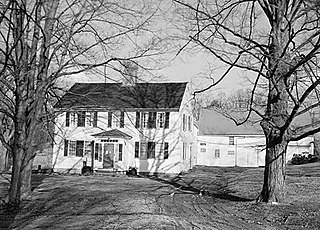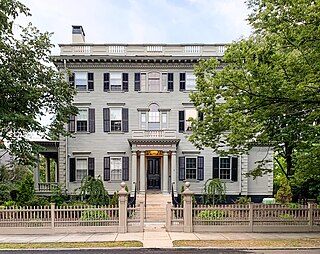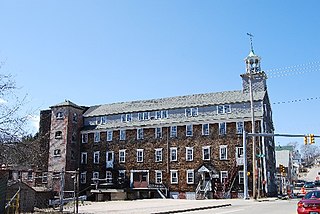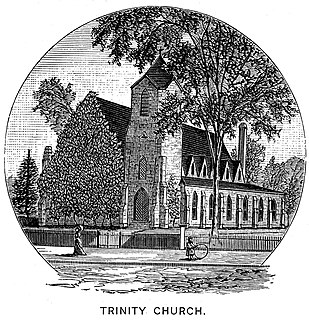
The John Sullivan House is a historic house at 21 Newmarket Road in Durham, New Hampshire. A National Historic Landmark, it was the home of American Revolutionary War General John Sullivan (1740-1795), who later became President of New Hampshire.

The Nelson W. Aldrich House, also known as the Dr. S. B. Tobey House, is a Federal-style house at 110 Benevolent Street in the College Hill neighborhood of Providence, Rhode Island. The house was the home of Nelson W. Aldrich, a U.S. Senator from 1881 to 1911. Aldrich was a dominant and controversial figure in the Senate, exercising significant control over the legislative process. This house, one of two surviving properties associated with Aldrich, was declared a National Historic Landmark in 1976. It is now a house museum operated by the Rhode Island Historical Society.

The Jenckes Mansion is an historic house in Woonsocket, Rhode Island. This three-story brick double house was built in 1828 by the Jenckes family, owners of the mills around which this area of Woonsocket, known as Jenckesville, grew. The building exhibits late Federal styling, and is distinctive as a rare example of a period private residence with ballroom. This space, located on the building's attic space, was divided into residential spaces c. 1900, when the building was converted into a tenement house.

The Dr. George W. Carr House, also known simply as Carr House, is an historic house at 29 Waterman Street in the College Hill neighborhood of Providence, Rhode Island. The Queen Anne style house was built in 1885 by Edward I. Nickerson and added to the National Register of Historic Places in 1973.

The John Waterman Arnold House, home to the Warwick Historical Society, is an historic house at 11 Roger Williams Avenue in Warwick, Rhode Island. Built in the late 18th century, it is a two-story five-bay wood-frame structure with a central chimney, and a two-story ell extending to the rear.

The Peter Greene House is a historic house in Warwick, Rhode Island. The 2+1⁄2-story wood-frame house was built c. 1751, probably by the sons of a militia captain named Peter Greene, and is a rare surviving 18th-century house in Warwick. It has a five-bay facade with a plain door surround, a central chimney, and a rear ell.

The Greene–Durfee House is a historic house at 1272 West Shore Road in Warwick, Rhode Island. The house, a 2+1⁄2-story wood-frame structure with a large central chimney, stands set well back from the west side of the road, opposite Church Avenue and a small cemetery. It is set behind a small wood-frame commercial building and is partially screened from view by bushes. Built c. 1780, it is one of the city's finest Georgian style houses, with a particularly well-preserved interior.

The Lippitt Mill is an historic mill at 825 Main Street in West Warwick, Rhode Island.

The Colonel Micah Whitmarsh House is an historic house in East Greenwich, Rhode Island. The 2-1/2 story Greek Revival style brick house was built c. 1767-1771 by John Reynolds, and acquired in 1773 by Micah Whitmarsh, a founding member of the local Kentish Guards militia, which are located nearby in the Armory of the Kentish Guards. It is distinctive as the only brick house on Main Street. It has been owned since 1966 by the East Greenwich Historical Society.

Trinity Episcopal Church was a historic church located at 48 Main Street in Pawtucket, Rhode Island. Built by the Episcopalians, the building was sold to the Catholics in 1977 and became the St. George Maronite Catholic Church within the Diocese of Providence. The church burned down in 2005, and was not rebuilt.

Saint Paul's Episcopal Church is a historic building in Columbus, Ohio.
Christopher Lippitt was a prominent Revolutionary War officer and founder one of the earliest textile mills in Rhode Island.

Lippitt, Rhode Island is a village within the town of West Warwick, Rhode Island.

John Holden Greene (1777-1850) was a noted early nineteenth century architect practicing in Providence, Rhode Island. The bulk of his work dates to the late Federal period, and is mostly in the architectural style of the same name. Greene is responsible for the design of over fifty buildings built in the city between 1806 and 1830, almost half of which are still standing.

The John Stickel House is a historic house built of lava rock located in Jerome, Idaho, United States.

William R. Walker was an American architect from Providence, Rhode Island, who was later the senior partner of William R. Walker & Son.
The Kent County Brigade was formed as part of the Rhode Island Militia during the American Revolutionary War. The Brigade was composed of 3 Regiments of 19 Companies from the towns of Warwick, East Greenwich, West Greenwich, and Coventry.
Waterman House may refer to:
The Pawtuxet Rangers is an active independent military organization of the Rhode Island militia that was founded in 1774 and currently serves primarily as a ceremonial honor guard and as historic educators. The Pawtuxet Rangers operates an armory museum in historic Pawtuxet village in Warwick, Rhode Island.
















